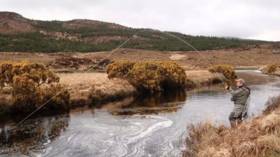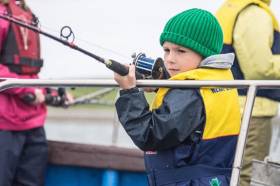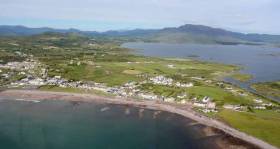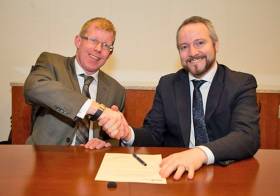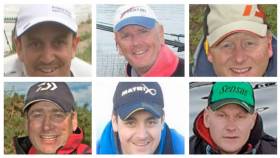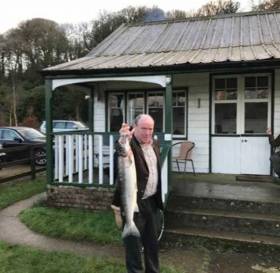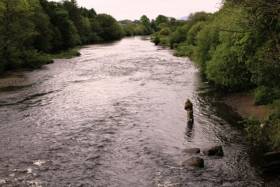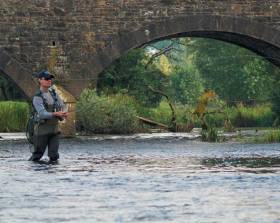Displaying items by tag: angling
Permit Reminder For Anglers As Gweebarra Fishery Opens
#Angling - Inland Fisheries Ireland says it is fully committed to the ongoing protection of the Gweebarra fishery in accordance with the High Court judgement of Justice Laffoy delivered on 19 December 2012.
Anglers wishing to fish the Gweebarra fishery from the opening of the angling season tomorrow (Saturday 1 April) are required to have a valid licence and permit, which are available from the village shop in Doochary, Glenties Angling Centre (phone 074 955 1141) or online from Donegal Angling Holidays.
A halt on fishery offence summonses, as previously reported on Afloat.ie, has prompted IFI to withdraw a number of cases, including those related to the Gweebarra fishery which were before the Donegal courts in recent days.
However, in the interim all current provisions and offences of the Inland Fisheries Acts continue in fill force and effect, and any alleged offenders remain liable to prosecution.
#Angling - A total of 79 angling initiatives — almost double the number of recipients in 2016 — will be supported to the tune of €30,000 in Inland Fisheries Ireland’s (IFI) 2017 Sponsorship Scheme.
This year’s recipients were decided with a focus on those which help grow Ireland’s angling tourism product and support novice anglers:
- 19 international angling events which will be held in Ireland.
- 15 Irish angling teams travelling overseas to international angling events.
- 28 coaching/juvenile events aimed at novice and young anglers.
- 16 national angling events held in Ireland for domestic participants.
- 1 seminar which will help the exchange of information, ideas and practical experiences on fisheries management.
The angling groups, located in 19 counties across the country, will be supported through financial aid and where possible, through resource support from IFI staff.
The sponsorship scheme was announced in December with applications invited from anglers, angling clubs and organisations nationwide. In total, there were over 100 applications to this year’s fund.
Suzanne Campion, IFI head of business development, said: “We have a unique opportunity in Ireland when it comes to angling as a result of our beautiful landscapes and wild fish populations. This is coupled with a large number of engaged angling groups across the country.
“We are committed to supporting those groups in helping to increase participation in angling and to position Ireland as a premier national and international angling destination. This will grow the recreational availability and contribution of angling to communities across Ireland and will also support businesses and jobs in rural communities.”
IFI’s National Strategy for Angling Development aims to increase overseas angling visits from 163,000 in 2015 to 173,000 and increase domestic participation of 273,000 anglers annually by 0.5%.
Angling in Ireland is currently worth €836 million to Ireland’s economy annually, supporting upwards of 11,000 jobs. If increase in participation is realised, angling could bring in an additional €53 million annually and support 18,000 jobs.
Find more more information on the initiatives awarded funding under the 2017 sponsorship scheme HERE.
Angling tourists to Waterville, Co. Kerry spend on average €644 during their stay, according to research published today by Inland Fisheries Ireland with assistance from the Economic and Social Research Institute (ESRI). The research, which was carried out withthe Waterville Lakes and River Trust, highlights the significant recreational and economic value of the fisheries resource to the area.
The Waterville Angler Survey, which surveyed 207 anglers during the 2015 angling season found that, on average, angling visitors to Waterville spend €644 per fishing trip or €114 per day. The impact of this expenditure is far reaching across the local community with €451 spent on non-angling items such as accommodation, restaurants/cafes and groceries and €193 of angling expenditure on items such as angling guides, boat hire and equipment.
The daily spend of anglers in Waterville (€114) far exceeds the spending of non-angling visitors to Ireland. Fáilte Ireland’s Tourism Facts Report 2015 cites expenditure of non-angling visitors and holiday makers at €68 and €89 per person per day in 2015.
Angling visitors also show huge loyalty to Waterville which is a renowned fishing destination for domestic and overseas anglers. Of those surveyed, 40 per cent have visited the area more than 20 times with 60 per cent visiting 10 times or more, an extremely high return rate in tourism terms. Anglers tend to spend a few days in the area with almost a quarter (24 per cent) staying longer than a week, 25 per cent staying two nights and a further 24 per cent staying two or three nights. An incredible 99.5 per cent of those surveyed said they would like to return to Waterville again.
Angling was often the sole attraction of the area to these visitors with 40 per cent taking part in no alternative activities during their stay. The majority of anglers travelled to Waterville with friends or family with two thirds (68 per cent) reporting that their party contained between two to four anglers who fished during their stay. They came from Great Britain (17.5 per cent), mainland Europe (5 per cent), other overseas areas (2 per cent) and Ireland (75.5%).
Ciaran Byrne, CEO of Inland Fisheries Ireland said: “Waterville is one of Ireland’s many precious fishing locations. Ireland is known for its indigenous wild fish populations and beautiful scenery which make it a top angling destination. This research in the Waterville area confirms that angling is bringing huge economic value to this rural community. We know that anglers to Waterville often visit outside of the Summer Months (May 40 per cent, April 28 per cent and October 19 per cent), thereby extending the season for tourism season providers. Anglers also tend to develop a relationship with an area which can lead to them taking multiple trips per year.
We cannot underestimate the importance of protecting this resource both in terms of our responsibility to the aquatic habitat and the fish that live there, but also to the community and local businesses which benefit hugely from the resource throughout the year.”
Key Findings from the Waterville Angler Study:
- On average angling visitors to Waterville spend €644 per fishing trip, which breaks down as €114 spend per day
- 53% have visited Waterville for more than 10 years, and 31% have visited for more than 20 years
- Almost a quarter (24 per cent) of anglers stay longer than a week, 25 per cent staying two nights and a further 24% staying two or three nights
- Anglers came from Great Britain (17.5 per cent), mainland Europe (5 per cent), other overseas areas (2 per cent) and Ireland (75.5%).
- Anglers from Great Britain stay in Waterville an average of 8.2 nights during their trips and Irish anglers stay on average for 3.2 nights
- Nearly half of respondents (44%) preferred to stay in B&B accommodation with 18% choosing Self Catering and 15% staying in Hotels.
- The most popular months for angling visitors are June (57%) and September (48.7%) along with July (45.5%), August (44%) however May (40%), April (28%) and October (19%) still attract angling tourism, outside of the traditional tourism season.
- Lake fishing was the most popular (87%), 46% fished the rivers and 40% participated in shore angling
- 84% of respondents fished for sea trout, 76% for salmon and 48% for brown trout.
Inland Fisheries Ireland Signs Up To Save Energy With SEAI
#IFI - Inland Fisheries Ireland has officially signed up to the Sustainable Energy Authority of Ireland’s (SEAI) Partnership Programme, which helps integrate energy management into public sector organisations.
This new partnership will see IFI follow a clear path to achieving targeted energy savings of 33% across the public sector, with a view to achieving year-on-year savings of greater than 3% on top of the 21% increase in efficiency already reached sector-wide.
The State fisheries body says it has already commenced a number of energy saving initiatives in recent years, which include the introduction of ‘green patrols’ for fisheries officers using kayaks and bicycles to patrol angling areas on inland waterways; installing solar panels and insulation on buildings; fuel monitoring and fleet audits; altering lighting; and trialling an electric vehicle.
IFI chief executive Dr Ciaran Byrne commented: “As custodians of the fisheries resource, Inland Fisheries Ireland recognises the importance of energy management as a highly cost-effective means of reducing greenhouse gas emissions and helping to reverse climate change.
“Today [Tuesday 7 March] we have formally committed to reducing our energy usage and our carbon emissions and we look forward to working with the SEAI on reaching our goal by 2020.
“There are many benefits to energy efficiency and aside from environmental reasons; we are also motivated by the desire to operate in a lean manner. We know that many organisations can achieve 20% monetary savings in energy use through proven management and technology solutions so as an organisation, we will benefit year on year.”
Jim Gannon, CEO of the SEAI, added that the agency “is working closely with the public sector to help them to achieve energy savings and agencies such as IFI have a key role to play.
“Already, public bodies have achieved more than €600 million in energy efficiency savings in the last few years with SEAI’s assistance. With more partnerships like the one Inland Fisheries Ireland has committed to today, even more public sector savings can be achieved as we move towards a low carbon future.”
Social Media Post Fuels Dispute Between Anglers Over Non-Native Species In Western Lakes
#Angling - Plans to introduce non-native fish species into Irish lakes have been alleged by Irish angling enthusiasts, as the Mayo News reported recently.
A social media post via the Irish Pike Society, which has since been removed, claimed that fishermen from the UK and Ireland were planning this month to introduce various non-native fish such as catfish and barbel into designated brown trout fisheries that include Lough Mask and Lough Conn.
Inland Fisheries Ireland confirmed they were aware of the claims and were monitoring the situation.
According to the Connacht Tribune, the allegation is the latest incident in an ongoing dispute between anglers who want to keep western loughs free of predatory fish like pike, and others who feel undue preference is given to salmon and trout.
Irish Angling Team Announced For 2017 Feeder Worlds
#Angling - The National Coarse Fishing Federation of Ireland (NCFFI) has announced its line-up for the 2017 FIPS-ed Feeder World Championships.
Michael Buchwalder, Nick Howell, Cathal Hughes, Johnny McKinnley, Rimantas Kondrackas and Paul Leese comprise the team to represent Ireland in Portugal this June.
“I am very pleased to be able to present a refreshed world championship team this year, and welcome the three new members to the squad,” said team manager Brenton Sweeney. “In the last three years, Ireland has achieved a team silver medal and four section wins and we are currently ranked 12th in the world.
"It has always been my ambition to introduce younger members to the squad and it’s great to start my second term by welcoming the enthusiastic Johnny and Rimantas along with Nick, who brings extensive knowledge of international championships.
“Former team member Philip Jackson and Paul Heaney of Lurgan CAC will provide support to the team in Portugal and I’m delighted to appoint Philip my assistant manager as we coach these anglers at home and away.
“I would like to take this opportunity to thank the NCFFI and our sponsors for their invaluable support as we look to the year ahead.”
Teams are also being assembled for the European Championships in Italy this May and the Worlds in Belgium in September, as well as the Home Internationals in Scotland the following month.
The NCFFI is a voluntary body, a member of the Angling Council of Ireland and the national governing body for coarse and predator angling recognised by Sport Ireland and SportNI.
First Salmon of 2017 Caught in Cork
The first salmon of 2017 has been caught in the Careysville Fishery on the Munster Blackwater on the opening day of the river, according to Inland Fisheries Ireland. Angler Ronan O’Connor caught a fresh run salmon on Wednesday, 1st of February in Fermoy, Co. Cork.
The salmon, which weighed 7lbs, was confirmed as the first salmon caught in 2017 by Inland Fisheries Ireland today. The fish was caught while the river was high with around two foot visibility at 4pm on Wednesday. O’Connor’s success followed a morning of stormy weather which cleared slightly before he managed to catch the elusive salmon.
Ciaran Byrne, CEO of Inland Fisheries Ireland said: “The 2017 fishing season has commenced in earnest now and we are delighted that the first salmon of the New Year has been caught. Ireland is known as an angling destination across Europe as a result of its indigenous wild fish populations and impressive scenery. With over 273,600 domestic anglers in Ireland, Ronan O’Connor did extremely well to secure the title for catching the first fish of 2017.
We look forward to growing angling participation in Ireland even more this year. Our fisheries resource is hugely valuable and offers rural communities sustainable tourism and job opportunities outside of the traditional tourist seasons. We will continue to work with these communities to develop our angling infrastructure and improve access with a view to increasing angling participation and growing local economic growth as a result.”
Anglers looking for fishing information in Ireland in 2017 can visit www.fishinginireland.info for the latest news and fishing reports. For those looking to try out fishing for the first time, Inland Fisheries Ireland will run a number of Education and Outreach initiatives throughout the year.
Salmon Angling Drought Finally Ends As Ireland Sees First Catch-Free January On Record
#Angling - Angling enthusiasts fear for the health of Ireland’s salmon stocks after the first ever catch-less January since records began, according to the Belfast Telegraph.
Dubliner Ronan O’Connor landed Ireland’s first salmon of 2017, a seven-pounder, on the Blackwater in Cork in recent days – over a month since the season began on open rivers across the island.
Towards the end of January, Belfast Telegraph angling correspondent Vic Thomas said the situation was “worrying” and “puzzling”.
"About five years ago the first fish was always caught on the first day in January - it is unusual,” he noted.
Thomas’ concerns have been echoed by River Downes Fishery owner Shane Gallagher, who added that “it is difficult to remain optimistic about the future of Irish salmon angling when more than half our rivers are closed to anglers and salmon licence sales have almost halved since 2002.”
The Belfast Telegraph has more on the story HERE.
Public Consultation On River Erne Trout Conservation Byelaw
#Angling - Inland Fisheries Ireland is seeking submissions from angling enthusiasts and other interested parties in relation to a proposal to introduce a byelaw to:
- Introduce a minimum takeable size limit for trout of 30cm (12”).
- Introduce a bag limit of two trout per angler per day.
The proposed byelaw would apply to all waters of the River Erne upstream of Derryheen Bridge, west of Butler’s Bridge, Co Cavan, including the waters of the Cavan River, Annallee, Dromore, Laragh, Bunnoe and Knappagh tributaries.
Submissions should be marked ‘Public consultation – Annallee-Dromore (River Erne)’ and sent by email to [email protected] or by post to:
The Director,
Inland Fisheries Ireland,
Station Road,
Ballyshannon,
Co Donegal
All submissions must be received in writing and will be published on the Inland Fisheries Ireland website.
The closing date for receipt of submissions is 5pm on Thursday 2 March.
IFI Outlines Efforts In Protecting Ireland’s Inland Fisheries Resource
#Angling - Inland Fisheries Ireland (IFI) spent 188,404 staff hours and carried out 31,180 patrols in 2016 to protect Ireland’s fisheries resource, it was announced yesterday (Wednesday 25 January) at the launch of the IFI Protection Review.
The review highlights the results of recent protection work of the nation’s fisheries resource, which contributes €836 million annually to the Irish economy.
IFI’s programme saw fisheries officers patrol the entire resource – which includes 74,000km of rivers and streams, 128,000 hectares of lakes and 5,500km of coastline – in their attempts to apprehend those responsible for illegal fishing or angling and environmental offences.
Some key findings from the Fisheries Protection 2016 Review include:
- 103 prosecution cases initiated for breaches of fisheries and environmental legislation, regarded as one of the most important tools in the prevention of illegal fishing activities in the long term.
- 1,487 items of illegal fishing equipment seized, including 301 illegal fishing nets which measured 14,782 metres in total – about the same distance from Leinster House to Dublin Airport.
- 22,066 environmental inspections across a variety of sites including farms, industrial premises, wastewater plants, forestry sites and wind farms as well general inspections for pollutants in the natural habitat. Inspections were carried out by environmental officers with a view to mitigating against potential environmental incidents which could have a detrimental impact on fish populations and fish habitats.
- 36,979 inspections of recreational anglers carried out nationwide to ensure anglers were compliant with the fisheries acts, which aim to protect fish populations.
Minister of State for Inland Fisheries Sean Kyne, who opened IFI’s Oireachtas Briefing Day event yesterday, said: “Close to 200,000 man hours speaks for itself but I want to commend Inland Fisheries Ireland for the immense and dedicated efforts they have put into protecting our invaluable inland fisheries resource.
“The vast array of river, lake and coastal based habitats present huge logistical challenges for our frontline protection staff and for Inland Fisheries Ireland management. These challenges are being met by augmenting traditional patrol and protection methods with state-of-the-art surveillance technologies and new and innovative patrol methods in the ever changing environment in which services are delivered.”
IFI chief executive Dr Ciaran Byrne added: “The role of Inland Fisheries Ireland is to act as steward of the inland fisheries resource and that role is crucial as we endeavour to protect and conserve Ireland’s aquatic habitat and the wild, indigenous fish populations who live within it.
“Our fisheries and environmental officers worked relentlessly in 2016 to ensure the continued availability of this resource to communities nationwide for recreational and business opportunities.
“The resource contributes €836 million to the Irish economy every year and in particular, it supports rural and peripheral communities through tourism opportunities which may not be there otherwise. Our National Strategy for Angling Development outlines how we can grow the economic contribution by an additional €96 million per year and our protection programme goes hand in hand in helping us realise those ambitions.”
The fisheries protection programme comprised planned day and night patrols, covert patrols and intelligence-led surveillance operations, and specifically targeted the fish species most at risk during particular seasons.
The principle methods used for patrols were boats (1,151 patrols), kayaks (188 patrols) and personal water craft (37 patrols) while land-based patrols were carried out using quad bikes (84 patrols), bicycles (363 patrols) and by vehicles and foot (29,357 patrols).
In addition to the use of traditional methods, fisheries officers used advanced surveillance equipment including night vision scopes, thermal imaging scopes and enhanced optical surveillance scopes to help them in their work.
IFI’s National Strategy for Angling Development is the first national framework for the development of Ireland’s angling resource. The strategy will deliver a wide-ranging set of investments, innovations and promotions to ensure that fish stocks and angling infrastructure are protected and enhanced and will see an investment of €25 million over the next five years to grow the socio-economic contribution of angling in Ireland.
Last year, over €1 million was invested by IFI in angling development projects alone, which included 50 angling access projects as part of the Capital Grants Fund plus ongoing investment in more than 4,000 angling structures.


























